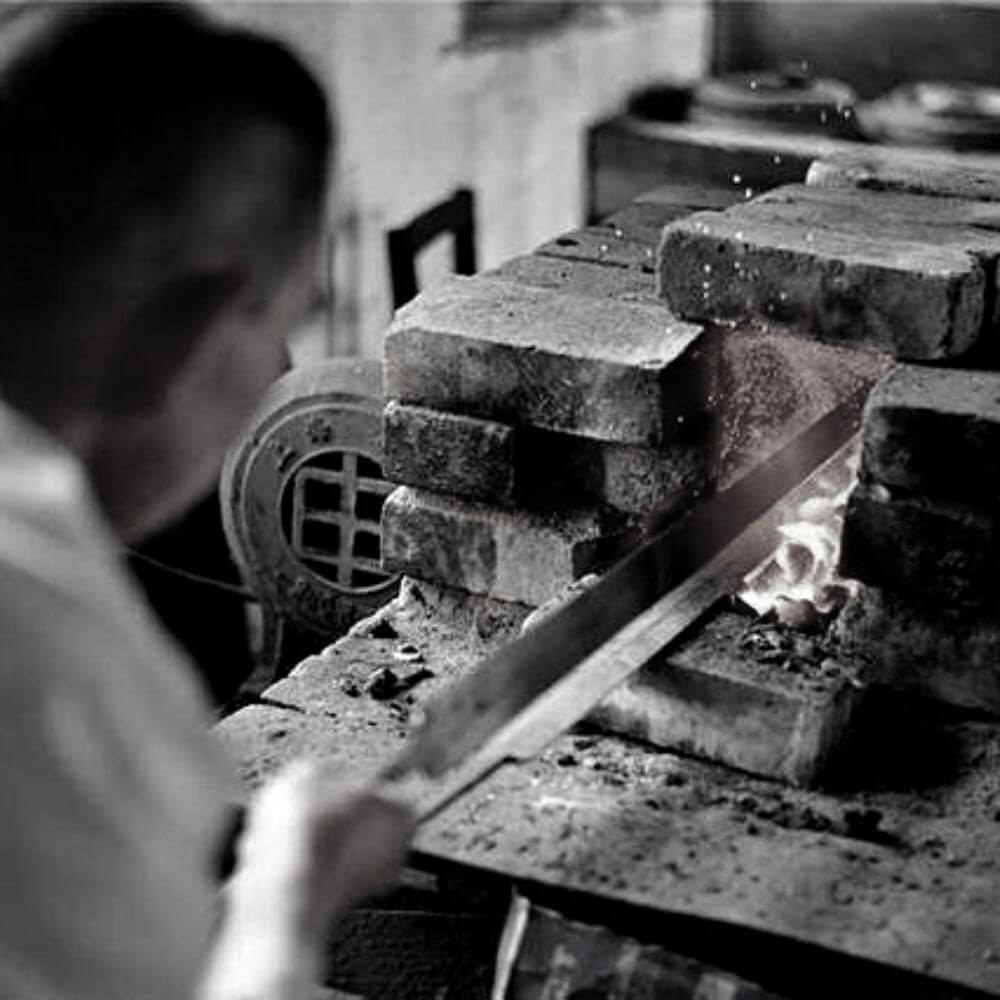How many types of Japanese swords are there, and what are the differences between military swords and samurai swords?
Japanese swords can generally be categorized into command swords, military swords, cavalry sabers, bayonets, and samurai swords. Military swords, also known as war swords, were carried by Japanese military officers. They served three primary purposes: representing the officer's rank, commanding troops in battle, and being used as a weapon for cutting and thrusting. Different branches of the military and different ranks carried different types of military swords and command swords. The cavalry saber was a specialized military sword used by the Japanese cavalry. Bayonets, also known as bayonet knives, were combined with rifles and submachine guns and were part of the standard equipment for Japanese soldiers, mainly used in close combat. Samurai swords were the exclusive weapons of the Japanese samurai and could be further divided into functional samurai swords and ceremonial samurai swords.

The command sword has three main functions: firstly, to represent the officer's rank; secondly, to command troops in battle; and thirdly, to be used in close combat for cutting and thrusting, making it a self-defense weapon.
Additionally, there is another type of command sword that has the same blade and scabbard as the aforementioned command sword but differs in the design of the guard and handle. The handle is wrapped with copper wire around wooden panels and sharkskin, and the exterior of the handle is covered with a copper sheet featuring a dragon motif.
Japanese military swords include army swords, navy swords, and air force swords.

The army sword consists of four parts: the blade, the handle, the guard, and the scabbard. The blade is forged from steel; the guard is made of brass and gold-plated (mainly for officer swords), rectangular in shape with cherry blossoms at the four corners. The handle is wrapped with brown silk ribbons around wooden panels, with copper decorations featuring cherry blossom patterns at both ends, and is engraved with the forging date, place, and the craftsman's name. The handle is attached to the blade using a bamboo pin. The scabbard is made of steel and lacquered in colors such as brown or green, with copper decorations featuring cherry blossom patterns at both ends, and a copper hanging ring. There are distinctions between general officer swords, company officer swords, and non-commissioned officer swords.
During World War II, a type of military sword was manufactured at the Tokyo Arsenal. Unlike previous swords, it had a round steel guard and an aluminum handle, with the handle and blade joined by a screw. This type of military sword had the character "東" (East) and a serial number engraved on the blade.

Additionally, there is a type of Japanese general officer sword that is 955mm in total length, with a blade length of 875mm and an edge length of 665mm. On the surface, it appears similar to other styles of general officer swords, but its differences become evident upon disassembly. Unlike earlier Japanese military swords, which had the forging date, location, and craftsman's name engraved on the handle, this sword only has the date engraved, not in the usual format of "Showa XX year," but as "Showa Kōshin year." It lacks the location and craftsman's name, instead bearing inscriptions such as "Kōa Isshin" and "Made by Mantetsu," or simply "Mantetsu." The inscription indicates it was made during the Showa period. "Made by Mantetsu" suggests that the materials for this sword came from iron ore plundered from northeastern China, smelted into steel, and then forged. "Kōa Isshin" is a slogan reflecting Japan's imperialist ambition to occupy China and dominate Asia.
This type of general officer sword has scabbards in two colors: green and dark brown. Apart from the color, the handle, scabbard, and decorations are similar to other military swords.

A Japanese naval vice admiral's sword measures 940mm in total length, with a blade length of 760mm and an edge length of 598mm. The right side of the handle is engraved with "August of the 9th Year of Kanbun," and the left side is inscribed with "Nagazumi Okimasa." Based on the inscription, the sword was forged in August of the 9th year of the Kanbun era (1669) during the Yamato period, and the craftsman was Nagazumi Okimasa. The sword consists of the blade, guard, handle, and scabbard. The inscription is in cursive script, the guard is made of copper and oval-shaped, with a design featuring the Japanese military flag. The handle is wrapped with brown silk ribbons around wooden panels and sharkskin, with platinum-plated copper cherry blossom decorations at both ends. The handle and blade are connected with a bamboo pin. The scabbard is made of wooden panels and sharkskin, black in color, with platinum-plated copper cherry blossom decorations at both ends and two hanging rings. The platinum plating of the decorations is a distinctive feature of Japanese naval officer swords. This naval sword is finely crafted and is a beautiful piece of craftsmanship. The swords of junior and senior officers have the same style but with slightly less elaborate decorations.

The Japanese air force swords I have seen have inscriptions on the handle and a specific emblem, with the rest resembling army swords. The sword's total length is 1065mm, with a blade length of 860mm and an edge length of 662mm. The handle inscription reads: "Noshu Seki Resident Fukuda Mitsu," indicating that the sword was forged in Noshu, Japan, by Fukuda Mitsu. The blade is forged from steel, and the scabbard is made of steel, coated with brown lacquer, and decorated with flight motifs at the top.
Samurai swords are divided into functional samurai swords and ceremonial samurai swords. The blades of samurai swords are similar to those of military swords, but their handles, guards, and scabbards are different. The scabbard of a samurai sword is made of wooden panels, lacquered in various colors. The guards come in various shapes, including square, rectangular, round, and oval, with no fixed pattern. The handle is made of wooden panels, sharkskin, and copper decorations, wrapped with silk ribbons, and attached to the blade with a bamboo pin.
Ceremonial samurai swords consist of the blade, guard, handle, and scabbard. The blade is forged from high-quality steel, slightly curved, with a blood groove 680mm long. The handle is made of wooden panels, sharkskin, and copper-silver plated decorations, wrapped with brown silk ribbons, with floral-patterned copper-silver plated decorations on both sides. The guard is made of brass, octagonal with a design, and has four symmetrical peach-shaped holes. The scabbard is wooden, lacquered, with copper-silver plated decorations, and the back of the scabbard is wrapped with brown silk ribbons with two hanging rings at the wrapping. The ceremonial samurai sword I have seen is 1050mm in total length, with a blade length of 945mm and an edge length of 715mm. The blade is inscribed, with the right side reading: "Auspicious Day in February of the 9th Year of Kyōhō" and "Twelve-section Shinmaru Forged," and the left side reading: "Yamato no Kami Fujiwara Tadayuki." This indicates the sword was forged in the 9th year of Kyōhō and used by Yamato no Kami Fujiwara Tadayuki.
The cavalry saber is a specialized sword for Japanese cavalry, with a Western-style design. Its construction and decoration are simpler than those of command swords. The blade is forged from steel, and the guard and handle are made of steel and wooden panels, with the wooden handle and steel guard connected by a bolt and nut.

Similarities Between Japanese Military Swords and Samurai Swords
1. Blade Forging: Both military swords and samurai swords are meticulously forged, with great attention paid to the quenching process. They often feature wave-like patterns on the blade.
2. Blade Details: The blades of both types are quite similar. The handles typically have inscriptions, including the forging date, location, and the craftsman's name. Most inscriptions are in Chinese characters, with very few using Japanese characters.
3. Blade Construction: The method of forging, as well as the thickness and width of the blades, are essentially the same, with the primary difference being in length. The width of the blade near the base is 30-32mm, at the middle 26-27mm, and near the tip 21-22mm. The thickness of the blade near the base is 8-10mm, at the middle 6mm, and near the tip 6-7mm, with the thinnest part being 4-4.5mm.
Differences Between Military Swords and Samurai Swords
1. Handle and Guard:
- Military Swords: The handle of a military sword is shorter than that of a samurai sword. The guard is rectangular with cherry blossom patterns at the corners. Officer swords have gold-plated guards.
- Samurai Swords: The guard (tsuba) of a samurai sword comes in various shapes, such as round or square, with no fixed pattern, often featuring artistic designs, making them valuable collectibles.
2. Scabbard:
- Military Swords: The scabbard is made of steel and comes in colors like brown or green. Army swords typically have one hanging ring, while naval swords have an additional sharkskin cover, are black in color, and have two hanging rings.
- Samurai Swords: The scabbard is made of wood, lacquered, often with hand-painted designs, and typically lacks hanging rings. Ceremonial samurai swords, however, may have two hanging rings.








Deja un comentario
Tenga en cuenta que los comentarios deben aprobarse antes de que se publiquen.